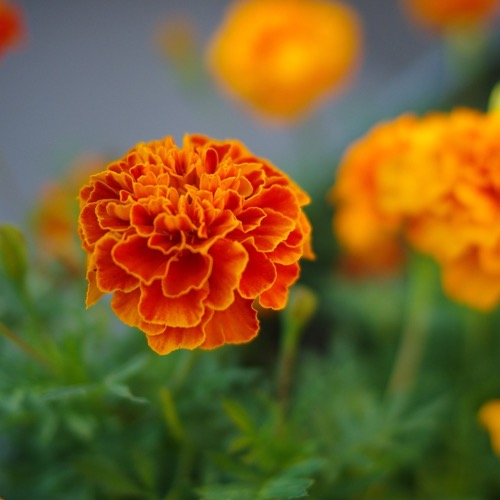Growing, Caring, and Benefiting from Vibrant Marigolds
Introduction
Welcome to our gardening blog, where today we explore the vibrant world of marigolds. Known scientifically as Tagetes, marigolds are more than just a burst of color in your garden; they are versatile, easy to grow, and have a range of uses beyond their visual appeal. In this comprehensive guide, we’ll delve into the various aspects of marigolds, from their botanical background to their care, providing you with all the information you need to successfully incorporate these cheerful blooms into your garden.
Botanical Overview
Common Names: Marigold, Tagetes
Scientific Name: Tagetes genus
Family: Asteraceae
Marigolds are annual plants known for their vibrant yellow, orange, and red flowers. Native to the Americas, they have become a popular choice in gardens globally due to their easy cultivation and pest-repellent properties.
The Tagetes genus includes several species, with Tagetes erecta (African marigold) and Tagetes patula (French marigold) being the most commonly grown. These species can be cultivated in a wide range of USDA hardiness zones, generally thriving in zones 2 through 11.
They are generally adaptable to a wide range of USDA hardiness zones, thriving best in zones 2 through 11. This wide range indicates their robust nature and ability to grow in various climatic conditions.
To give you a better understanding of what these zones mean:
- Zone 2: One of the coldest gardening zones, with minimum temperatures reaching as low as -50 to -40 degrees Fahrenheit.
- Zones 3 to 11: These zones cover a spectrum of climates, from colder regions where frost is common to warmer areas with milder winters.
- Zone 11: Characterized by a tropical climate, with minimal risk of frost.
Marigolds are particularly versatile in terms of climate adaptability. They can handle a variety of temperatures but generally prefer and thrive in warmer conditions with plenty of sunlight. It’s their preference for sunnier locations that makes them suitable for a broad range of zones, including those with hot summers. However, in extremely hot climates, they may require some afternoon shade to prevent scorching.
As a general guideline, marigolds are annuals, meaning they complete their life cycle in one growing season. In colder zones, they will die off with the first frost, whereas in warmer zones, they might last longer into the year.
Varieties of Marigolds
Marigolds are known for their vibrant colors and easy care, making them a favorite among gardeners. Here are some of the most popular varieties of marigolds (Tagetes), along with descriptions:
- Tagetes erecta (African Marigold): This variety is known for its large, pompom-like blooms that can be up to 5 inches in diameter. The flowers come in shades of yellow, orange, and white. African marigolds are taller than other varieties, often reaching up to 3 feet in height. They are excellent for creating a dramatic visual impact in the garden.
- Tagetes patula (French Marigold): French marigolds are smaller and bushier than African marigolds, with flowers that are typically 2 inches across. Their blooms come in a mix of oranges, yellows, reds, and even bicolor patterns. French marigolds are often used for borders and container planting due to their compact size.
- Tagetes tenuifolia (Signet Marigold): These marigolds are distinctive for their delicate, lacy foliage and small, single-petaled flowers. The flowers are daisy-like, appearing in shades of yellow and orange. Signet marigolds are often used in rock gardens and as edging plants due to their lower growth habit and dainty appearance.
- Tagetes lemmonii (Mexican Marigold): Also known as the Mexican tarragon, this variety is known for its marigold-like flowers and anise-scented leaves. It produces clusters of small, golden-yellow flowers and is used both as an ornamental plant and as a culinary herb.
- Tagetes lucida (Sweet Mace or Mexican Mint Marigold): This variety is known for its small, yellow-orange flowers and anise-flavored leaves. It’s commonly used in cooking and as an ornamental plant. Sweet mace is a perennial in warmer climates but can be grown as an annual in cooler regions.
- Tagetes minuta (Muster-John-Henry): Characterized by its tall growth and small, yellowish-white flowers, this variety is known for its strong, pungent aroma. It’s often used for its insect-repelling properties and is considered more of a utility plant than an ornamental.
Each of these marigold varieties offers unique characteristics, making them suitable for different gardening needs and preferences, from ornamental uses to culinary applications. Marigolds bring their own charm and can be used to achieve different visual effects in garden design.
Planting and Growth Conditions
Sunlight – Marigolds thrive in full sun but can tolerate partial shade. Soil – They prefer well-drained soil and are relatively adaptable to different soil types.
Planting – Spring is the best time to plant marigolds, after the last frost date.
Care and Maintenance
Watering – Regular watering is necessary, but overwatering should be avoided to prevent root rot.
Fertilizing – A balanced, all-purpose fertilizer can be applied occasionally to promote growth.
Pruning – Deadheading (removing spent blooms) encourages more flowering.
Benefits and Uses
Marigolds are not only visually pleasing but also offer several practical benefits:
- Pest Repellent: Their scent is known to repel certain pests, making them great companion plants in vegetable gardens.
- Soil Improvement: Some marigolds are believed to help in controlling nematodes in the soil.
- Edible Flowers: Certain varieties have edible flowers, adding both color and flavor to salads and other dishes.
A Little More About Companion Planting & Tagetes
Companion planting with marigolds (Tagetes) is a popular and effective gardening practice. Marigolds are known for their ability to repel certain pests and improve soil quality, making them excellent companions for various plants. Here are some key points on companion planting with marigolds:
Benefits of Companion Planting with Marigolds
- Pest Repellent: Marigolds release a chemical from their roots and foliage that repels nematodes and other garden pests, making them beneficial when planted near susceptible crops.
- Attract Beneficial Insects: The bright flowers of marigolds attract pollinators and beneficial insects that help control harmful pests.
- Soil Improvement: Some marigold varieties are believed to improve soil health by controlling nematodes, a type of parasitic worm.
Best Companion Plants for Marigolds
- Vegetables: Marigolds are particularly beneficial when planted near tomatoes, peppers, eggplants, potatoes, and cucumbers. They help deter pests like tomato hornworms and root-knot nematodes.
- Herbs: Planting marigolds near herbs like basil and mint can enhance their growth by reducing pest infestation.
- Flowering Plants: Marigolds can also be planted with other flowering plants such as petunias and geraniums, creating a vibrant and diverse garden that is more resistant to pests.
Plants to Avoid Planting Near Marigolds
While marigolds are generally compatible with many plants, there are a few exceptions:
- Beans: It’s generally advised to avoid planting marigolds near beans, as they can inhibit bean plant growth.
- Cabbage Family: Some gardeners suggest that marigolds might not be beneficial when planted near members of the cabbage family, such as broccoli, cauliflower, and kale.
How to Use Marigolds for Companion Planting
- Border Planting: Plant marigolds around the edges of your vegetable garden or between rows to create a natural pest barrier.
- Interplanting: You can also plant marigolds interspersed among your vegetables and flowers for a more integrated pest management approach.
- Pot Planting: If space is limited, growing marigolds in pots placed near susceptible plants can also be effective.
Incorporating marigolds into your garden through companion planting can significantly enhance the health and vitality of your plants. Not only do they add beauty and color, but their pest-repelling properties and soil improvement benefits make them invaluable allies in achieving a thriving, productive garden.
Potential Problems
While marigolds are generally hardy, they can face issues such as:
- Pests and Diseases: Keep an eye out for common garden pests and fungal diseases, though they are relatively resistant.
- Overcrowding: Space them adequately to ensure healthy growth and air circulation.
Conclusion
Marigolds, with their radiant flowers and easy-going nature, are a fantastic addition to any garden. Ideal for both novice and experienced gardeners, these plants offer beauty and utility with minimal maintenance. Incorporate the lively spirit of marigolds into your garden and enjoy the vibrant display and practical benefits they bring.
Frequently Asked Questions About Marigolds
- What are Marigolds? Marigolds are a genus of flowering plants in the family Asteraceae, known for their vibrant orange, yellow, and red blooms. They are popular in gardens for their beauty and pest-repelling properties.
- Are Marigolds Easy to Grow? Yes, marigolds are known for being easy to grow. They are hardy, adaptable, and can thrive in a variety of soil and climate conditions, making them great for beginner gardeners.
- What Types of Marigolds Are There? The most common types are African marigolds (Tagetes erecta), French marigolds (Tagetes patula), and Signet marigolds (Tagetes tenuifolia), each differing in size, flower shape, and color.
- How Do I Plant Marigolds? Plant marigolds in well-drained soil under full sun. They can be grown from seeds sown directly in the ground or from seedlings. Ensure they are spaced properly to allow for growth.
- When Should I Plant Marigolds? Plant marigolds after the last frost in spring. They grow best in warm weather and can be planted throughout the summer.
- How Much Water Do Marigolds Need? Marigolds need moderate watering. Once established, they are relatively drought-tolerant, but consistent watering promotes healthy growth, especially in hot, dry conditions.
- Do Marigolds Attract Pollinators? Yes, marigolds attract bees, butterflies, and other pollinators, making them beneficial for gardens.
- Can Marigolds Be Used in Companion Planting? Absolutely! Marigolds are great for companion planting as they repel certain pests and can improve soil quality, benefiting neighboring plants.
- Are Marigold Flowers Edible? Yes, certain varieties of marigold flowers are edible and are used to add color and flavor in culinary dishes.
- Do Marigolds Have Medicinal Properties? Historically, marigolds have been used for their medicinal properties, including anti-inflammatory and antiseptic uses, though these should be approached with caution and proper knowledge.
- How Do I Manage Pests and Diseases in Marigolds? Marigolds are relatively pest-resistant, but they can occasionally suffer from aphids and fungal diseases. Regular monitoring and proper spacing for air circulation can help prevent these issues.
These FAQs cover the basics of growing and caring for marigolds, helping you enjoy these vibrant and beneficial flowers in your garden.
Links:












You must be logged in to post a comment.